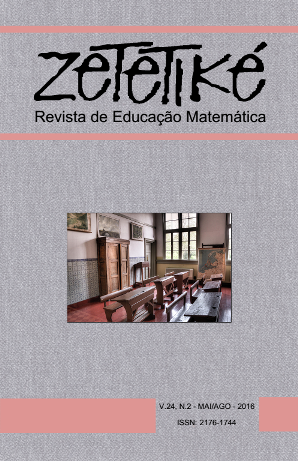Abstract
In this article, we reflect on how mathematics teachers build geometric justifications based on geometric
relations and properties as they solve a task about quadrilaterals and their angle bisectors, all within the online
environment, Virtual Math Teams with GeoGebra (VMTwG). The teachers, participants in a continuing
education project with digital technologies, work collaboratively in small teams to construct geometric figures and solve geometric problems. Given a sequence of tasks designed for discussion and resolution within a
collaborative online environment, we analyze how three teachers collaboratively and discursively construct theoretical justifications based on their own conjectures and perceptions of relations among geometric objects,
without the use of measurement. These theoretical justifications and the conditions in which it manifested
generate implications for mathematics teacher education and for teachers’ classroom practice.
References
ALAGIC, G., & ALAGIC, M. (2013). Collaborative mathematics learning in online environments. In D. Martinovic, V. Freiman, & Z. Karadag (Eds.), Visual Mathematics and Cyberlearning (Vol. 1, pp. 23-48). New York: Springer.
AMARAL, R. B. (2011). Argumentação matemática colaborativa em um ambiente online. Acta Scientiae, 13(1), 55-70. Retirado em 12 de novembro de 2013, de http://www.periodicos.ulbra.br/index.php/acta/article/view/23/20.
ARZARELLO, F., Olivero, F., Paola, D., & Robutti, O. (2002). A cognitive analysis of dragging practises in Cabri environments. International Reviews on Mathematical Education (ZDM), 34(3), 66-72.
CHRISTOU, C., Mousoulides, N., Pittalis, M., & Pitta-Pantazi, D. (2004). Proofs through exploration in dynamic geometry environment. International Journal of Science and Mathematics Education, 2(3), 339-352.
GATTEGNO, C. (1987). The science of education: Part 1: Theoretical considerations. New York: Educational Solutions.
HÖLZL, R. (2001). Using dynamic geometry software to add contrast to geometric situations – A case study. International Journal of Computers for Mathematical Learning, 6(1), 63-86.
MISHRA, P., & Koehler, M. J. (2006). Technological pedagogical content knowledge: A framework for teacher knowledge. Teachers College Record, 108(6), 1017-1054.
ÖNER, D. (2008). Supporting students’ participation in authentic proof activities in computer supported collaborative learning (CSCL) environments. Computer-Supported Collaborative Learning, 3, 343-359.
POWELL, A. B. (2014). Construção colaborativa do conhecimento tecnológico, pedagógico e do conteúdo de professores de matemática. Boletim GEPEM, 64, 88-103.
POWELL, A. B., & Alqahtani, M. M. (2015). Tasks and meta-tasks to promote productive mathematical discourse in collaborative digital environments. In I. Sahin, S, A. Kiray, & S. Alan (Eds.), Proceedings of the International Conference on Education in Mathematics, Science & Technology (pp. 84-94). Antalya, Turkey.
POWELL, A. B., Borge, I. C., Floriti, G. I., Kondratieva, M., Koublanova, E., & Sukthankar, N. (2009). Challenging tasks and mathematics learning. In E. J. Barbeau, & P. J. Taylor (Eds.), Challenging mathematics in and beyond the classroom: The 16th ICMI study (pp. 133-170). New York: Springer.
POWELL, A. B., & Grisi-Dicker, L. (2012). Toward collaborative, discourse-focused learning with dynamic geometry environment. In Proceedings of the 12th International Congress on Mathematical Education (pp. 1-10). Seoul, Korea: ICME.
POWELL, A. B. & Lai, F. F. (2009) Inscriptions, mathematical ideas, and reasoning in VMT. In G. Stahl (Ed.), Studying virtual math teams. (ch 13, pp. 237-259). New York, NY: Springer.
SFARD, A. (2000). Symbolizing mathematical reality into being. Or how mathematical discourse and mathematical objects create each other. In P. Cobb, E. Yackel, & K. McClain (Eds.), Symbolizing and communicating in mathematics classrooms: Perspectives on discourse, tools, and instructional design (pp. 37-98). Mahwah, NJ: Lawrence Erlbaum Associates.
SILVERMAN, J. (2011). Supporting the development of mathematical knowledge for teaching through online asynchronous collaboration. The Journal of Computers in Mathematics and Science Teaching, 30, 61-78.
STAHL, G. (Ed.). (2009). Studying virtual math teams. New York: Springer.
STAHL, G., Koschmann, T., & Suthers, D. (2008). Aprendizagem colaborativa com suporte computacional: Uma perspectiva histórica. Boletim GEPEM, 53, 11-42.

This work is licensed under a Creative Commons Attribution-NonCommercial-NoDerivatives 4.0 International License.
Copyright (c) 2016 Zetetiké: Revista de Educação Matemática

